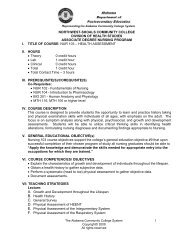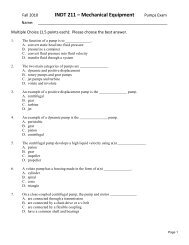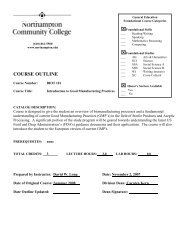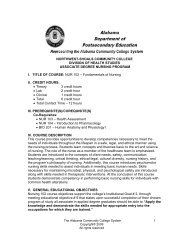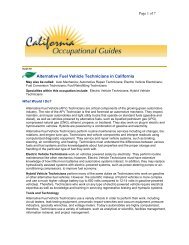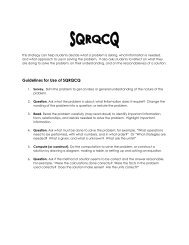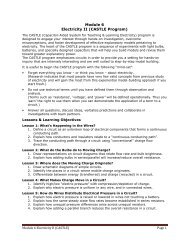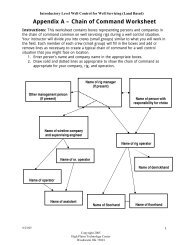i. Module 4 Fluids and Thermodynamics ... - Workforce 3 One
i. Module 4 Fluids and Thermodynamics ... - Workforce 3 One
i. Module 4 Fluids and Thermodynamics ... - Workforce 3 One
Create successful ePaper yourself
Turn your PDF publications into a flip-book with our unique Google optimized e-Paper software.
The instructor will use a Syringe to ignite a few str<strong>and</strong>s of cotton, todemonstrate the heating of a gas at increased pressure. Cotton placed atthe bottom of the tube ignites in a flash as the plunger causes rapidcompression of the gas inside the tube. If the cotton alone doesn’t workuse a match head.Also see a demonstration at:http://www.teachertube.com/view_video.php?viewkey=b9537c8753c09e08d4dfThis is a demonstration of what is called adiabatic compression where noheat is lost to the outside environment, in which the compression has tobe so fast that practically no heat generated by the compression isallowed to escape.The fire syringe demonstrates the relationship between pressure <strong>and</strong>temperature. When the pressure on a gas is increased, the particles(atoms <strong>and</strong> molecules) are forced to move in a smaller space. This canbe shown when a ping-pong paddle is lowered onto a bouncing ping-pongball. The intervals between the ball striking the paddle decrease as thepaddle is lowered. The French scientist Joseph Gay-Lussac concluded thatequal volumes of all gases exp<strong>and</strong> the same with identical increases intemperature. This is known as the Gay-Lussac's Law.This also explains how canning creates a vacuum seal. As the temperature inside the jardecreases <strong>and</strong> atmospheric pressure seals the lid tightly.The Diesel EngineDiesel engines rely on the relationship between pressure <strong>and</strong> temperature. There are nospark plugs in a diesel engine. The fuel is sprayed into the cylinder of compressed airwhere, because of the relationship between pressure <strong>and</strong> temperature, the fuel ignites <strong>and</strong>the exp<strong>and</strong>ing gases from the ignition forces the engine piston downward.The diesel engine uses a four-stroke combustion cycle justlike a gasoline engine.Intake stroke -- The intake valve opens up, letting in air<strong>and</strong> moving the piston down.Compression stroke -- The piston moves back up <strong>and</strong>compresses the air.Combustion stroke -- As the piston reaches the top, fuelis injected at just the right moment <strong>and</strong> ignited, forcingthe piston back down.Exhaust stroke -- The piston moves back to the top,pushing out the exhaust created from the combustion outof the exhaust valve.See:http://auto.howstuffworks.com/diesel1.htmhttp://library.thinkquest.org/C006011/english/sites/diesel.php3?v=2<strong>Module</strong> 4 Student Guide <strong>Fluids</strong> & <strong>Thermodynamics</strong> Page 8



